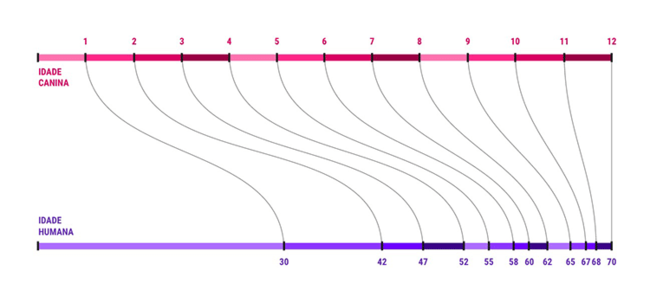learn to calculate dog age
Dog age is very different from human age, as the two species age in different ways.

Jametlene Reskp Unsplash image
Anyone who has dogs knows that the age of a dog is very relative and some people like to try to calculate the ratio of the years that the dog lives with the age of a human. The maxim that you just multiply the dog's age by seven to have a comparison with human age is not entirely accurate. With that in mind, researchers at the University of California at San Diego School of Medicine analyzed the relationship between the canine and human genomes to create a more accurate graph that helps to know how old a dog would be in human years.
The results, published in the journal Cell Systems, indicate that a dog may be older than it looks. The researchers analyzed the DNA of 104 Labrador animals, aged 0 to 16 years, to draw a more accurate parallel between canine and human aging. The main finding was that there is, indeed, a correlation between the ages of the two species, but that it is not linear as per popular wisdom. "A nine-month-old dog can have puppies, so we already know that the 1:7 ratio is not an accurate measure of age," noted medical professor Trey Ideker in the study.
Analyzing blood samples from the Labradors, the team coordinated by biologist Tina Wang found that dogs age faster in their first years. Over time, the aging rate slows down: it's as if at 1 year, the dog was 30 human years; at age 4, their biological age is 52 years old for a human being. It's important to note that the research was based on Labradors - some breeds live longer or shorter.
dog age x human age
Check out the chart created based on the research:

Source: Wang. T. et AL., Cell Systems, 20202. Image by Portal eCycle
The method used to measure and compare the different stages of development and aging between dogs and humans was to quantify DNA methylation, that is, as methyl groups (set of three hydrogen and one carbon atoms, CH3, with one free electron ) become incorporated into the genetic material over time. According to biologist Clarissa Carvalho, PhD in evolutionary biology from the University of Sheffield, UK, methylation patterns function as molecular “wrinkles” that accurately indicate the age of cells, tissues or organisms.
In biology jargon, this relationship between DNA methylation levels and the life span of organisms operates like an epigenetic clock. Epigenetics studies changes in the functioning of organisms that occur without the DNA base sequence having been modified, as is the case of changes caused by methylations.
Researchers have other aspirations besides helping you realize that your dog is "older" than you thought. The study wants to articulate a new formula to determine the age of a cell, tissue or organism, which should bring many possibilities. The research could pave the way for measuring the age of adopted dogs or measuring the effectiveness of antiaging interventions (for humans, in this case), among other options.
According to Trey Ideker, professor in the departments of Medicine and Bioengineering and Computer Science at UCSD, in an interview given to university bodies, “dogs are interesting animals to study because, by living so close to us, they are exposed to them. environmental and chemical factors that affect humans throughout life, in addition to receiving health care similar to ours”. He also explains that a better understanding of the aging process can guide veterinary diagnoses and treatments, in addition to serving for the development and evaluation of antiaging drugs.










